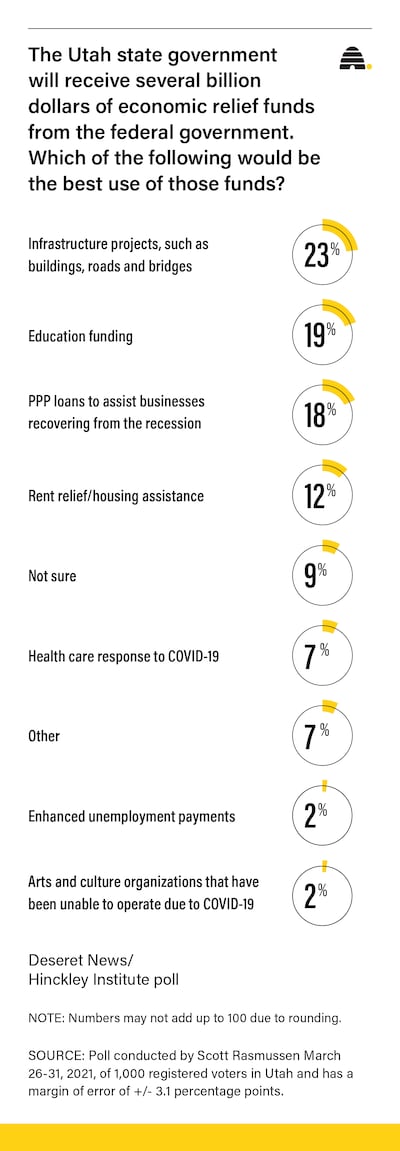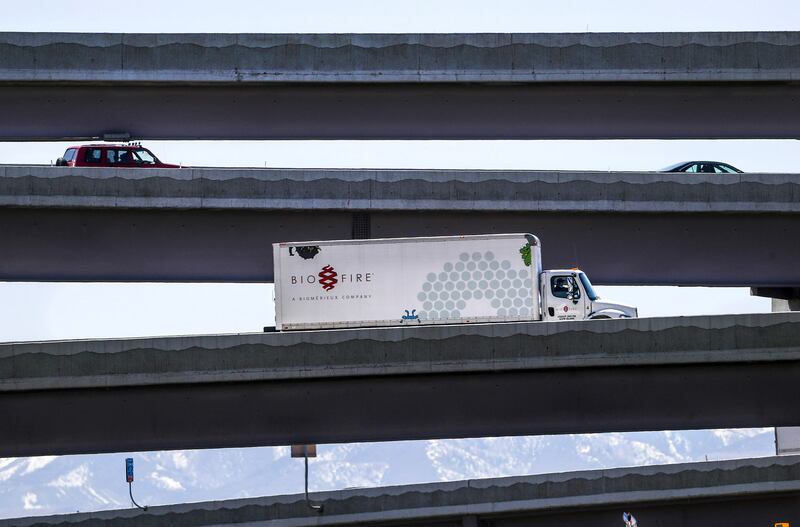Infrastructure projects are at the top of most Utahns’ minds as the biggest priority on which state leaders should spend billions in federal COVID-19 relief funds that are coming to Utah.
A new Deseret News/Hinckley Institute of Politics poll found 23% of Utahns want the Utah Legislature to spend the money on infrastructure projects such as roads, bridges and buildings. Coming in at a close second, 19% of Utahns think the funds would be best spent on education.

Not far behind, about 18% said the money should be spent on PPP loans to assist businesses recovering from the recession, and 12% say that money should go toward rent relief and housing assistance.
A smaller number of Utahns want the money spent in other ways, with 7% prioritizing health care response to COVID-19, 2% for enhanced unemployment payments, and 2% for arts and culture organizations that have been unable to operate due to the pandemic.
About 9% say they aren’t sure how the money should be spent, and 7% responded “other.”
Pollster Scott Rasmussen conducted the survey of 1,000 Utah registered voters March 26-31 for the Deseret News and the University of Utah’s Hinckley Institute of Politics. Poll questions have a margin of error of plus or minus 3.1 percentage points.
The poll comes ahead of a spring special session in which the Utah Legislature will decide how to spend a “stunning” amount of money from the $1,9 trillion coronavirus relief package Congress passed last month. The sweeping American Rescue Plan will direct an estimated $7 billion to $8 billion to the state of Utah, state fiscal analysts estimate. Of that, state government is in line for an estimated $1.5 billion and local governments $1 billion.
‘They have lost their minds in Washington’
Utah’s all-Republican congressional delegation voted against the spending bill, saying it’s wasteful, saddles future generations with insurmountable debt and is largely unneeded in a state with one of the healthiest economies in the country. Utah’s GOP legislative leadership also expressed concerns about the long-term ramifications of the massive spending package, but said now that Utah’s getting the funds, they’ll make sure to invest them wisely.
“We will take our fair sure of the funding and we will use it to the benefit of the state as much as we possibly can,” House Speaker Brad Wilson, R-Kaysville, told the Deseret News.
“But I think they have lost their minds in Washington, D.C. Who in the world is going to pay for all of this and how are we going to pay for it? ... Utah is in such good financial shape right now that we’d be fine without this money, but we’ll use it to the highest and best use we can.”
Senate President Stuart Adams said he’s also “really concerned” about inflation and rising interest rates, so “we need to think long term, not short term.”
Wilson said though Utah doesn’t necessary need the stimulus money, it will take it so Congress isn’t “rewarding bad behavior” from states that aren’t as fiscally responsible as Utah.
Utah ranked near the top in the nation for revenue growth in 2020 despite the pandemic, for which state leaders credited the state’s already strong economy and the “balanced” approach the state took to COVID-19 restrictions.

Expect more infrastructure investment
Jason Perry, director of the University of Utah’s Hinckley Institute, said the poll results are to be expected, with roads and education often top issues on the minds of Utahns.
“These are very close to home,” Perry said, also noting that President Joe Biden and his administration have also been discussing major infrastructure investments at a national level. “So it makes sense it’s being received well here at home as well.”
Told of the poll, Adams, R-Layton, jokingly asked the Deseret News: “Are the people who answered these poll questions, are they legislators? I think the public’s pretty smart.”
He said the poll results align fairly closely with what he said legislators are likely to prioritize in the upcoming special session. Because the relief funds are one-time, Adams said lawmakers are likely to spend it on one-time infrastructure projects “because infrastructure is one of the biggest needs we have as a state.”
“We’re growing so fast. We’re one of the fastest growing states in the nation. We have to build infrastructure because of that growth,” he said.
Lawmakers earlier this year already budgeted massive amounts — nearly $1 billion in one-time money and $264 million in bonding — for infrastructure, but not as much as House leaders originally wanted.
Wilson also said infrastructure will likely be a top priority — but the real question for lawmakers is how they fund those construction projects without “creating inflationary concerns.”
“There’s already so much pressure on costs for construction already that if we aren’t really careful with how we use this (money), we could create massive inflationary problems for government, for individuals and for businesses, and we don’t want to do that,” Wilson said.
With major infrastructure investment also being discussed at the national level, the speaker said construction inflation it’s not an issue localized to Utah.
“We’re kidding ourselves if we think this inflationary concern is just in Utah,” he said. “This is a problem everywhere. There is a lack of building supplies, lack of labor, dramatic inflation in every state, and now we’re adding trillions of dollars of additional infrastructure spending at a time when we already have dramatic shortages. I don’t get it.”
Utah lawmakers have until 2024 to roll out the funds, so Wilson said they’ll have to be strategic about they way they spend it.
“We have a few years to deploy this money, so I think the first thing we’ll do is look at what are the biggest needs. Is it roads? Rail? Technology? What are the needs and then where do we have maybe some gaps,” Wilson said.
Water projects — especially funding for secondary water metering — is likely to be a big priority for the stimulus funding, both Wilson and Adams said.
Secondary water metering is “a really interesting idea and one that I think it’s time to have a conversation about,” Wilson said. “Not necessarily charging for usage but starting the metering so people understand how much water they’re using.”
That could cost at least $100 million, perhaps double, Wilson said, but legislators are still researching what that investment might entail and if it would span across the Wasatch Front.
“For a desert state, that might be the highest and best use of that money,” Wilson said.
Adams said it “would be nice to do something that’s generational” with the funding, also pointing to water infrastructure needs.
“Maybe some metrics to help us conserve — that’s going to be key to our water development,” he said.
Other priorities
As for other priorities listed in the poll, both Adams and Wilson said education is already getting a big chunk of federal funding directly, so they were noncommittal on whether lawmakers would pump any additional funds from state government.
“We’ll monitor that,” Adams said.
Utah lawmakers already invested historical amounts of money into education earlier this year, Wilson noted. He added education needs ongoing money, not one-time funds.
As for loans to assist businesses, both Adams and Wilson said legislators will likely be looking to fund more assistance for businesses that have been especially harder hit, particularly in the entertainment and hospitality industries.
“They’ve been devastated,” Adams said. “We will probably pivot a little bit and look to those businesses and try to focus on those that are still significantly hurt.”
As for housing and rental assistance, Adams and Wilson were also noncommittal on whether that issue will get more funding, though they didn’t rule it out. Lawmakers earlier this year already pumped about $50 million into affordable housing and homelessness.
“We will look at that,” Adams said. “The one bad thing about a good economy is housing prices, and that’s something we’ll continue to look at. I’m not sure we have a real solution for it, but I think we’ll do what we can to help with rent relief and housing.”
Wilson said there may be an “opportunity to consider” more funding for housing issues, but it’s not clear what those investments will look like. He said pumping too much money into the housing market could also continue to aggravate inflation for construction, and it takes years to realize the full benefits of the $50 million already invested.
“It’s just unbelievable what’s happening in the housing market,” Wilson said. “It’s scary. It’s really scary for people who don’t have homes or want to move right now, but that’s going to take years to work its way through the system.”
Wilson said perhaps state leaders will look at funding additional grants “to deal with the housing shortage and affordable housing,” perhaps more money into the state’s housing preservation fund or the Olene Walker Housing Loan Fund.
“The challenge is it has to be spent in the next couple of years and we already put a lot of money into the program,” Wilson said. “We’ll have to see how much we could realistically use over the next few years.”
Though it ranked lower in the poll, Wilson and Adams said lawmakers will also have to invest more into health care response to COVID-19, to keep vaccination rollout and testing going.
Wilson said lawmakers may also have some conversations about “what we can do to prepare for another health crisis like this and are there other investments we should be making,” or if the state should be preparing for other types of emergencies like earthquakes.
“So we’ll see how it all plays out,” he said.


